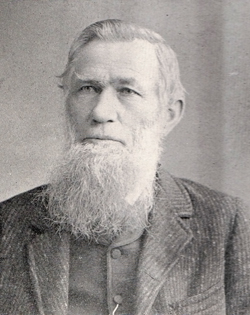Gerhard H. Timmerman, 1824–1910
|
Gerhard Heinrich Timmerman, born on 3 April 1824 in Schwagsdorf, Hanover, Germany, was the son of Wilhelm Dirker and Maria Engel (maiden name unknown) Timmerman. He began his life as the son of a peasant farmer in Hanover, Germany. He learned the trade of wood turner, making spinning wheels in Germany. Gerhard was one of several sons, one of whom, John H. Timmerman, had already immigrated to St. Louis. Because of the lack of opportunity in his homeland, Gerhard sailed to Baltimore on the ship, Schiller, in 1843 with two brothers, Francis, age twenty, and Mathias, age seventeen. He was just nineteen years old when he left his homeland. Gerhard married Mary Catherine Hackmann who was born on 8 September 1827 in Germany and died on 18 July 1913 in St. Louis, Missouri, on 27 November 1847. The Timmermans had ten children, four of whom survived to adulthood. After working a short time on the East Coast setting tenpins, driving a horse and cart, and fishing for herring on the Potomac River, he made his way to Pittsburgh and, from there, Cincinnati. Gerhard’s brother, John, worked as a teamster in St. Louis, so Gerhard decided to settle there, working for two years with his brother. Gerhard relayed to a newspaper reporter that “I gave up that job because the food was too rich and I couldn’t get used to three meals a day.” Once settled in St. Louis, Gerhard attended night school to learn English. Innovative and entrepreneurial by nature, Gerhard tried his hand at several businesses: a small grocery store, a boarding house, and a wagon yard. His crowning business achievement, and what made him a wealthy man, was the St. Louis Iron and Machine Works. Gerhard’s company invented machines for ice-making and plate glass manufacture and other heavy machinery which were highly regarded and shipped all over the country and to Mexico. Gerhard was known as the “Patent Governor” because of his ability to see a need and develop a machine. |
 Gerhard Timmerman Photo in the Public Domain |
|
As Gerhard grew older, his interests turned to health issues. He wrote editorials to the St. Louis Post-Dispatch, preaching about the harm of tobacco and other articles extolling the virtues of vegetarianism. Gerhard self-published books and pamphlets about “correct living,” including The Doctor in the Vest Pocket that he advertised for sale for twenty-five cents. Gerhard used his wealth to build Parkhurst, his summer home on the Meramec River in Valley Park, Missouri. Eventually, he transformed Parkhurst into a sanatorium, providing a healthy alternative to the bad air of the city. In 1887, Gerhard became part of an association to incorporate a college, St. Louis Hygienic College of Physicians and Surgeons. Gerhard donated money to help build Sacred Heart Catholic Church in Valley Park as well. Gerhard died of influenza at his home on 30 March 1910 in St. Louis, with burial at Calvary Cemetery. (Sources include newspapers and books.) Written by Elizabeth Barry Fallstrom |
|
Return to St. Louis City/County Biographies.
Last Modified: 25-Feb-2020 20:42